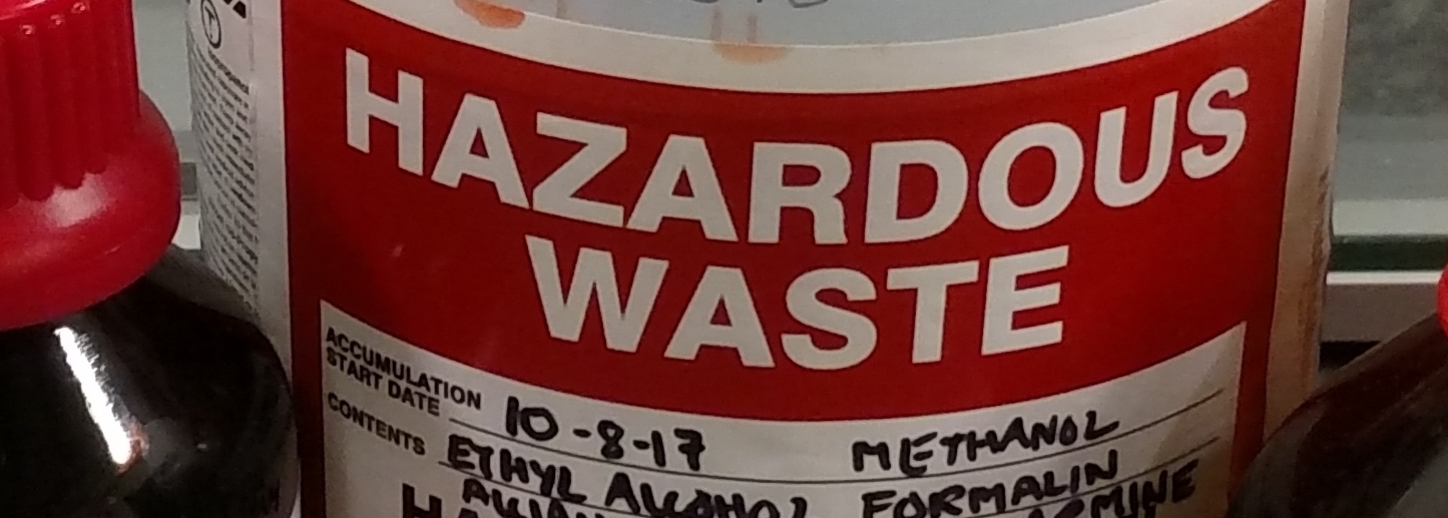
Hazardous Waste
Hazardous Waste Classification
Waste is considered regulated hazardous waste if it meets any of the following:
- On the F-list (non-specific source waste)
- On the P-list or U-list (discarded commercial chemical products)
- Exhibits any characteristic of hazardous waste as described below (flammable, corrosive, reactive, toxic)
Characteristic Waste
Waste is regulated as hazardous if it meets any of the following characteristics.
Hazardous: Flammable (Ignitable)
- A liquid with a flash point less than 60 degrees Centigrade
- A solid capable under normal conditions of causing fire through friction, absorption of moisture or spontaneous chemical changes
- A flammable compressed gas
- An oxidizer
Hazardous: Corrosive
- An aqueous with pH less than or equal to 2, or greater than or equal to 12.5
- A liquid that corrodes steel at a rate greater than 0.250 inches per year at 55 degrees Centigrade
Hazardous: Reactive
- Is unstable and readily undergoes violent change without detonating
- Reacts violently with water
- Forms potentially explosive mixtures with water
- Upon mixture with water generates toxic gases, vapors or fumes
- Generates toxic gases, vapors or fumes at pH conditions between 2 and 12.5
- Capable of detonation or explosive decomposition
- Classified as a Department of Transportation explosive
Hazardous: Toxicity Characteristic
- The waste contains certain metals, pesticides or selected organics above specified levels. See List of Toxic Characteristic Wastes
.( link is external) - if it is otherwise capable of causing environmental or health damage if improperly
disposed (this judgment is based on knowledge of the material).
Footnote: K-list waste codes are
Facilities projects are subject to a required protocol that identifies potential hazardous wastes.
Suspicious paint must be tested for before removal. Federal Law requires that individuals receive certain information before renovating 6 square feet or more of painted surfaces in a room for interior projects or more than 20 square feet of painted surfaces for exterior projects in housing, child care facilities and schools built before 1978.
Asbestos (Chemical Hygiene Plan 5.2.6.2)
Proper notifications must be completed prior to the demolition of a facility containing known Asbestos Containing Materials (ACM). Records of test results and any other documents pertaining to the removal process are maintained by the Chemical Hygiene Officer (CHO).
Polychlorinated Biphenyls (PCB’s.) (Chemical Hygiene Plan 5.2.6.3)
PCBs belong to a broad family of man-made organic chemicals known as chlorinated hydrocarbons. PCBs were domestically manufactured from 1929 until their manufacture was banned in 1979. They have a range of toxicity and vary in consistency from thin, light-colored liquids to yellow or black waxy solids. Due to their non-flammability, chemical stability, high boiling point, and electrical insulating properties, PCBs were used in hundreds of industrial and commercial applications including electrical, heat transfer, and hydraulic equipment; as plasticizers in paints, plastics, and rubber products; in pigments, dyes, and carbonless copy paper; and many other industrial applications. But, most fluorescent light ballasts manufactured before 1979 used capacitors containing PCBs. Sealed inside the capacitor is about a teaspoon of concentrated PCBs. Potting material surrounds the capacitor, which is encased in a ballast box. Magnetic ballasts containing PCBs must be disposed of in accordance with formal hazardous waste procedures. Contact the CHO - Mark Musser at (x4019) to
Secondary Containment (Chemical Hygiene Plan 5.2.6.4)
Ensure appropriate secondary containment is provided for all
Empty Cans and Containers (Chemical Hygiene Plan 5.2.7.6)
Chemical containers that have been emptied (generally this means drained of their contents by normal methods including pouring, pumping, aspirating, etc.) are not regulated as hazardous waste.
Training in proper waste handling and emergency procedures. (Chemical Hygiene Plan 5.2.7.7)
Training will be provided for individuals who handle hazardous waste as part of their job duties. Proper handling and storage procedures will be covered to protect stored items from breakage, or other damage. Containers must be closed, structurally sound, and compatible with its contents. They will also be trained in proper DOT shipping and receiving requirements.













